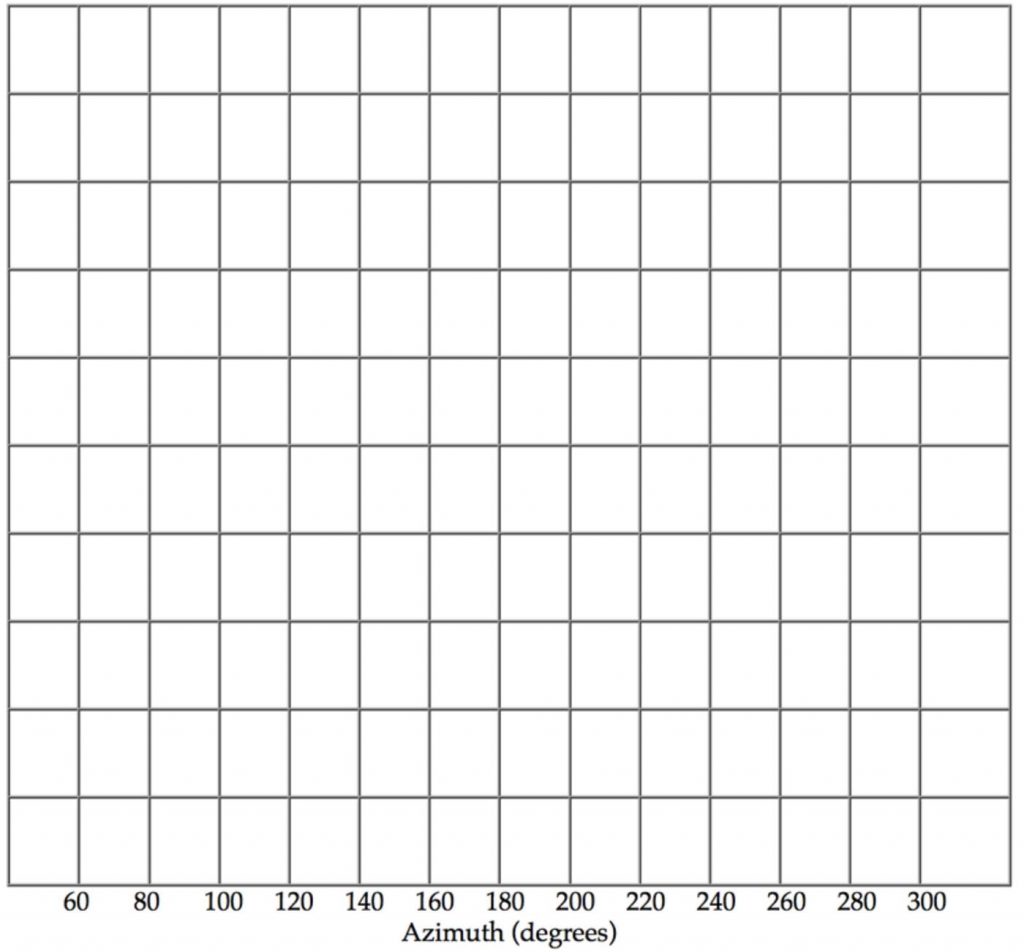AC3.3. Sun Movement
Originally:
The Position of the Sun During the Day
(A Partial Explanation for the Seasons)
[see also The Solar Calendar]
In this investigation you use the software Stellarium to take data of the Sun’s position over a period of a day. You’ll take the data for the summer solstice in June and the winter solstice in December. In astronomy we use two different coordinate systems to locate an object in the sky.
We use the Altitude/Azimuth (alt/az) system that allow’s us to communicate the position of an object to another person located nearby at a particular time of day or night.
Altitude: The angle measured from the horizon upwards toward the zenith.
Units: degrees between 0 and 90. (0 degrees at the horizon; 90 degrees at the zenith)
Azimuth: The angle measured in a circle along the horizon from the North, to East, to South, to West and back to North. Units: degrees between 0 and 360.
Zenith: the point in the sky directly overhead
I. The position of the Sun during June 21.
- Open the software “Stellarium.”
Fix the location (wherever you choose),
date (June 21) and time (12 noon).
Keep open the “Date and Time” window. - In the menu at the bottom of the window make the following icons active:
Azimuth grid, Ground, Cardinal points, Atmosphere.
Leave all the rest inactive, including the constellations. - In the left-hand menu, click the third icon, “Sky and Viewing options window”.
Click “Markings.”
Click the boxes for Meridian Line and Ecliptic Line.
Close the window. - Move the sky until you have a view to the South.
Look for and click on the Sun.
You’ll see a window open in the upper-left corner showing information about the Sun.
Especially note the information Az/Alt—it is changing rapidly.
If you can’t read the information, remove the atmosphere using the icon in the bottom menu. - Now you’re ready to get data.
In the window “Date and Time” click the arrow below the hour in order to move to an earlier time.
As you click, watch the Sun move.
Continue clicking until the Sun is at the eastern horizon (sunrise).
Also change, if necessary, the minutes and seconds to get the Sun right at sunrise (Alt = 0).
What time was sunrise on this particular day?
In your Notebook, RECORD the time of sunrise. - Click on the Sun.
Read the azimuth and altitude for sunrise.
In your Notebook, MAKE A TABLE like the one below
and record the Az/Alt values for sunrise (0 hr).
You can also copy/paste the table into a spreadsheet or word processor, or make a new table from scratch. - Now change the time hour by hour.
Read the azimuth and altitude at each hour past sunrise.
RECORD the data in the table. - Continue until sunset at the western horizon.
What time will sunset be on this particular day?
RECORD the time of sunset in your Notebook.
The position of the Sun hour by hour:

- Draw a graph with the data (Az/Alt) in your table.
In your Notebook, MAKE A GRAPH like the one shown below.
You can also print the graph below by clicking on it and printing the resulting page.
Alternatively you can put your data into a spreadsheet and create your graph in that way. - Put azimuth on the X axis and altitude on the Y axis.
You won’t be using the hour data directly on the graph. - Answer the following questions using the data in the table and your graph.
- How many hours long was this day in June?
- How many hours after sunrise did the Sun pass over the meridian? This point is called “transit”.
- How many hours passed between “transit” and sunset?
- What is the altitude and azimuth of the Sun at transit?
- What is the maximum altitude of the Sun on this day?
Position of the Sun During One Day

II. The position of the Sun during Dec 21
- To complete this activity you’ll change the date on Stellarium to 6 months into the future, Dec. 21.
Go through exactly the same process and take the same data.
You can record it in the same table.
Record the data in the same way on the graph. - What are the differences between June and December in terms of the number of hours during the day and the maximum altitude of the Sun?
What are the differences in terms of where and when the Sun rises and sets?
These are the principal differences between summer and winter in terms of the Sun’s position. - Suggest how this data helps to explain the average temperatures during the winter months compared to the average temperatures during the summer months.
See also The Solar Calendar, about horizon Sun calendars that match horizon landscape features with sunset positions. Focus in particular is on the Cesar Chavez Memorial Solar Calendar in Berkeley CA.


